'Of Colours'
Of Colours.
1. The rays reflected from Leafe Gold are yellow but then transmitted are blew, as appears by holding a leafe of Gold twixt yor eye & a candle.
2. Lignum Nephriticum sliced & about a handfull infused in 3 {sic} or 4 pints of faire water for a night ye liquor (looked on in a cleare violl) reflects blew rays & transmits yellow ones. And if ye liquor being too much impregnated appeares (wn looked through) of a darke red it may be diluted wth faire water till it appeare of a Golden Colour.
3 The flat peices of some kinds of Glase will exhibit ye same Phænomena wth Lignum Nephritcum And these Phænomena of Gold & Lignum Nephriticum are represented by ye Prisme in ye 37th experiment as also in ye 22d|th| & 24th Experiment.
4 But Generally bodys {sic} wch appeare of any colour to ye eye, appeare of ye same colour in all positions; {Nay} Gold if it bee not soe very thin {illeg} as to bee transparent appeares onely yellow & perhaps ye yellow colour of Lignum Nephriticum would vanish if ye tincture bee strong & ye liquor of a greate thicknesse. And perhaps there are many coloured bodys wch if made so thin as to bee transparent would appeare of one colour { to ye} when looked upon & of another colour when looked through. Perhaps Motes in ye Sun doe so for they appeare coloured. And
5 The tincture of Lignum Nephriticum may bee deprived of its blew colour wthout any alteration made in ye yellow {sic}. by putting a little of any acid salt into it (as spirit of Salt \of/ vinegar, of Lemon juice, oyle of Vitrioll, Aqua fortis &c). Sulphureous Salts (whither Vrinous {illeg} (i.e. Volatile salts of Animal substances) as Spirit of hartshorne of Vrin; of blood, of Sal Armoniack; Or Lixiviate Vnctuous Alcalizate & fixed salts made by incineration as ye Solution of Salt of potashes, of common wood ashes, of lime water, Oyle of Tartar &c) doe restore ye blew colour wthout making any change in the yellow.
<2>Experiments wth ye Prisme
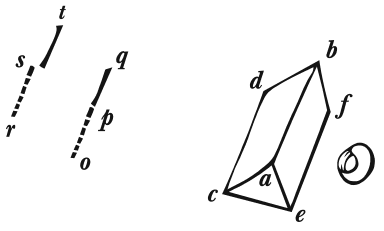 On a black peice of paper I drew a line opq, whereof one halfe op was a good blew ye other pq a good \deepe/ red (chosen by Prob. of Colours). And looking on it through ye Prisme adf, it appeared broken in two twixt ye colours, as at rst, ye blew parte rs being nearer ye vertex ab of ye Prisme yn ye red parte st. {illeg} {illeg} Soe yt blew rays suffer a greater refraction yn red ones. |Note| I call those blew \or red/ rays &c, wch make ye Phantome of such colours.
On a black peice of paper I drew a line opq, whereof one halfe op was a good blew ye other pq a good \deepe/ red (chosen by Prob. of Colours). And looking on it through ye Prisme adf, it appeared broken in two twixt ye colours, as at rst, ye blew parte rs being nearer ye vertex ab of ye Prisme yn ye red parte st. {illeg} {illeg} Soe yt blew rays suffer a greater refraction yn red ones. |Note| I call those blew \or red/ rays &c, wch make ye Phantome of such colours.
The same Experiment may bee tryed wth a thred of two colours held against ye darke.
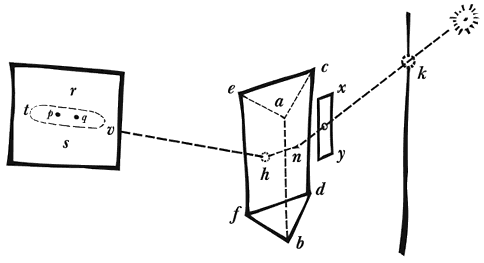 7 Taking a Prisme, (whose angle fbd was about 60dr into a darke roome into wch ye sun shone only at one little round hole k. The colours \{illeg}/ {illeg} {illeg} And laying \it/ ye Prism close to ye hole k in such manner yt ye rays, being equally refracted at (n & h) their going in & out of it {sic}, {illeg} cast colours \rstv/ on ye opposite wall. The colours should have beene in a round circle were all ye rays alike refracted, but their forme was oblong terminated at theire sides r & s wth streight lines; theire bredth rs being 2 inches, theire length to about 7 or eight inches, & ye centers of ye red & blew (q & p) being distant about 2 or 3 inches. The distance of ye wall trsv from ye Prisme being 260 inches
7 Taking a Prisme, (whose angle fbd was about 60dr into a darke roome into wch ye sun shone only at one little round hole k. The colours \{illeg}/ {illeg} {illeg} And laying \it/ ye Prism close to ye hole k in such manner yt ye rays, being equally refracted at (n & h) their going in & out of it {sic}, {illeg} cast colours \rstv/ on ye opposite wall. The colours should have beene in a round circle were all ye rays alike refracted, but their forme was oblong terminated at theire sides r & s wth streight lines; theire bredth rs being 2 inches, theire length to about 7 or eight inches, & ye centers of ye red & blew (q & p) being distant about 2 or 3 inches. The distance of ye wall trsv from ye Prisme being 260 inches
8 Setting ye Prisme in ye midst twixt ye hole k & ye {illeg} opposite wall, in ye same posture, & laying a boarde xy {illeg} betwixt ye hole k & ye Prisme close to ye Prisme, in wch board there was a small hole as big as ye hole k (viz: of an inch in Diameter) so yt ye rays passing through both those holes \to ye Prisme/ might all bee almost parallel (wanting lesse yn 7 minutes, whereas in ye former experiment some rays were inclined 31min). Then was the length & breadth of ye colours on ye wall every way lesse yn before \halfe ye former/ by about 2 inches viz rs = inch, tv = 2inch {illeg} inches. & pq = 1 inch Soe yt ye Red & blew rays wch were parallel before refraction may bee esteemed to be generally inclined one to another after refraction some more some lesse yn) 34min. And yt some of them are inclined more yn a degree, in this case. And therefore if theire sines of incidence (out of glasse into glasse \aire/) be of ye same, theire sines of refraction will generally bee in ye proportion of 285 to 286 & for ye most extreamly red & blew rays, they will bee as 130 {sic} to 131 {sic} +, {illeg}: ffor by experiment if their angle of incidence out of ye glasse into ye aire bee 30d. The angle refraction of ye red rays being 48gr 35': ye angle of refraction of ye blew rays will bee 48gr, 52', generally but if ye rays bee extreamly red & blew ye angle of refraction of ye blew rays may bee more yn 49gr, 5'.
9 In ye{illeg} 7th Experiment ye colours appeared in this order. but in ye 8th exper: when ye rays were more distinct & unmixed
10 Painting a good blew or red colour on a peice of paper neither of wch was much more luminous yn ye other (for carrying ym gadually into ye darke, both grew faint alike almost & disappeared together) if ye Prismaticall blew fell upon ye colours thay both appeared perfectly blew but ye red paint afforded much ye fainter & darker blew, but if ye Prismaticall red fell on ye colours then both appeared perfectly ble red but ye painted blew afforded much ye fainter Red. The Prisme was ordered as in ye 8th experiment. Note yt ye purer ye Blew | Red is ye lesse tis visible wth blew | Red rays.
<4>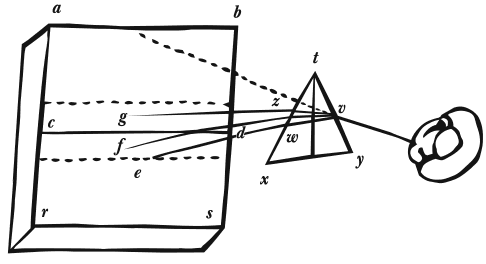 {illeg} of {illeg} colours 11 If ye plate abcdsr bee painted wth any two colours & abcd bee ye lighter colour, ye partition edge of ye Colours, cd will bee appeare through ye prisme txy of a red {sic} colour, bu{t} if cres bee ye lighter colour, their common edge cd 12 will through a prisme looke blew. 12 And this will happen though ye colours differ not in species but only in degrees, as if acdb bee black & cdsr darkness or blacker yn abdc ye edge dc will bee red & much more conspicuous yn ye black, wch is strange.
{illeg} of {illeg} colours 11 If ye plate abcdsr bee painted wth any two colours & abcd bee ye lighter colour, ye partition edge of ye Colours, cd will bee appeare through ye prisme txy of a red {sic} colour, bu{t} if cres bee ye lighter colour, their common edge cd 12 will through a prisme looke blew. 12 And this will happen though ye colours differ not in species but only in degrees, as if acdb bee black & cdsr darkness or blacker yn abdc ye edge dc will bee red & much more conspicuous yn ye black, wch is strange.
13 But if in a darke roome (as in Experimnt 10) ye prismaticall blew or redd fall on a paper abdc ye edges of ye paper will not \appeare/ otherwise coloured through \another/ Prisme yn to ye naked eye, viz: of ye same colour wth ye rest of ye paper. [ffor ye first Prisme perfectly seperats ye blew & red rays whereas I beleive \all/ ye colours proper to bodys are a little mixed.]
14 Prismaticall colours appeare in ye eye in a contrary order to yt {illeg} in wch they fall on ye paper.
15 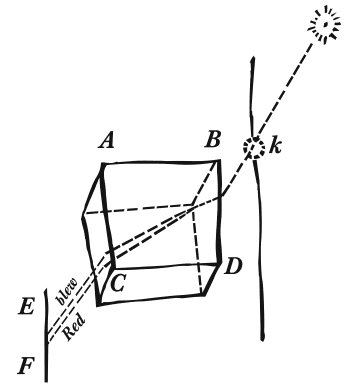 If a foursquare vessell abcd bee made wth two parallel sides of well pollished glasse AC BD, & bee filled wth water; And if ye sunns rays doe passing into a darke roome through ye hole k doe fall very obliquely on \ye glasse sides of/ ye vessell & {illeg} {through} ye rays at their egresse shall paint colours on ye paper EF on wch they fall. [The blew & red colours rays being seperated by ye first refraction.]
If a foursquare vessell abcd bee made wth two parallel sides of well pollished glasse AC BD, & bee filled wth water; And if ye sunns rays doe passing into a darke roome through ye hole k doe fall very obliquely on \ye glasse sides of/ ye vessell & {illeg} {through} ye rays at their egresse shall paint colours on ye paper EF on wch they fall. [The blew & red colours rays being seperated by ye first refraction.]
16 The colours are not made broader (as they would {be} were ye prisme triangular) by removing ye paper farther from ye vessell. [becaus ye blew & red rays become parallell againe after ye second refraction] if the rays pass through two holes near or close to ye vessell on either side ye colours
<5>17 The window k being opened yt ye Sun \or other terminated light/ might shine freely, If I limited ye rays by an opace body held twixt ye wall & ye vessel ye edge of ye bodys shaddow would not appeare coloured. But if ye said body were on yt side ye vessel towards ye sun its shaddow would be coloured on its edge
18. But in ye Triangular Prisme whither ye said body bee held on ye one side or on ye other the edges of its shaddow appeares coloured.
19. If you looke upon some uniformely luminous body (as on ye cleare sky or a sheet of white paper &c) through a triangular prisme. & hold ye said opace body on ye farther side of ye Prisme soe as to obscure {one} halfe \parte/ of ye said luminous body; the farther ye said {illeg} opace body is held from ye Prisme, ye more its edges will bee coloured; & ye nearer, ye lesse; untill ye colours {quite} \almost/ vanish when ye said body becomes contiguous to {illeg} \is held close close to/ ye Prisme.
20 But if instead of ye triangular Prisme you use ye said 4square vessell ABDC, held obliquely yt ye rays may bee much refracted in passing through it to ye eye when ye opake body is placed as {illeg} neare to ye {vessell} as you can distinctly see it, yor eye being close to ye  vessell, ye edges of ye said body will appeare coloured wch colours are diminished by removing ye body farther from ye vessell, & quite vanish when ye distance of ye said body is very greate. Thus ye Sun, by reason of his distance, appeares not coloured \on his edges {illeg}/ wn looked on through ye said vessell, & yet in ye 15th experiment hee trajects colours on a peice of paper.
vessell, ye edges of ye said body will appeare coloured wch colours are diminished by removing ye body farther from ye vessell, & quite vanish when ye distance of ye said body is very greate. Thus ye Sun, by reason of his distance, appeares not coloured \on his edges {illeg}/ wn looked on through ye said vessell, & yet in ye 15th experiment hee trajects colours on a peice of paper.
{21} The colours made by this vessel {illeg} appeare imediatly to ye eye in ye same order in wch they fall on paper but by ye △ Prisme yt order is divers.
{N}ote, That ye more ye \glasse/ sides of ye vessell ABCD are distant, {ye} better it is; yt distance should not bee lesse yn 6 or 8 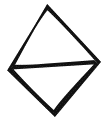 inches to make ye Phænomena conspicuous. Some of ye Phænomena may bee tryed by tying two Prismes thus
inches to make ye Phænomena conspicuous. Some of ye Phænomena may bee tryed by tying two Prismes thus  together: But ye distance of theire sides is too little to exhibit ym
together: But ye distance of theire sides is too little to exhibit ym
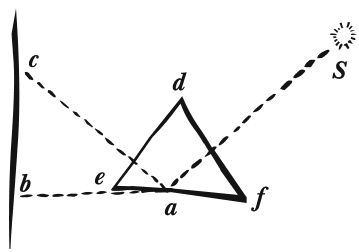 22. If ye sun S shine upon ye Prism def, some of his rays being transmitted through ye base ef will make colour on ye wall cb at b, others will bee reflected \{illeg}/ {illeg} colouring ye wall to ye wall at c making only a white wthout colours; Now if ye Prisme bee soe inclined as that ye rays ab bee refracted more & more obliquely, ye blew colour will at last vanish from b; soe yt ye red alone being refracted to b, ye blew will bee reflected to c & make ye white colour there to appeare a litttle blewish. But if ye Prisme bee \yet/ more inclined, ye red colour at b will vanish too & being reflected to c will make ye blewish colour turne white againe.
22. If ye sun S shine upon ye Prism def, some of his rays being transmitted through ye base ef will make colour on ye wall cb at b, others will bee reflected \{illeg}/ {illeg} colouring ye wall to ye wall at c making only a white wthout colours; Now if ye Prisme bee soe inclined as that ye rays ab bee refracted more & more obliquely, ye blew colour will at last vanish from b; soe yt ye red alone being refracted to b, ye blew will bee reflected to c & make ye white colour there to appeare a litttle blewish. But if ye Prisme bee \yet/ more inclined, ye red colour at b will vanish too & being reflected to c will make ye blewish colour turne white againe.
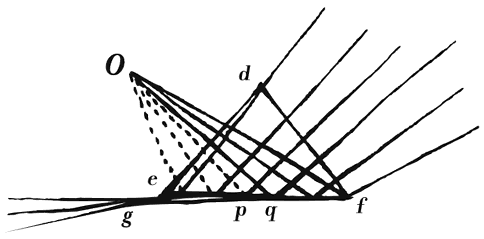 23. If in ye open aire you {sic} looke at ye Image of ye Sky reflected from ye {illeg} bases of ye Prism {illeg} ef, holding {illeg} yor eye \O/ almost perpendicular to ye basis you will see ye one part of ye sky ep (being as it were shaded wth a thin curtaine) to appeare darker yn ye other qf. [{illeg} ffor all ye rays wch can come to ye eye from qf, fall soe obliquely on ye basis as to bee all reflected to ye eye. Whereas those wch fall {soe} can come to ye eye from ep are so direct to ye basis as to bee most of ym {in front} transmitted to g]: & ye partition of those two parts of ye Sky, pq, appeares blew; [ffor ye inclinations of ye rays \{illeg}/, wch can come to ye eye from pq, are so inclined to ye basis yt all ye blew rays are reflected to ye eye whilst most of ye red rays are transmitted through to g {illeg} as in Experimnt 22]
23. If in ye open aire you {sic} looke at ye Image of ye Sky reflected from ye {illeg} bases of ye Prism {illeg} ef, holding {illeg} yor eye \O/ almost perpendicular to ye basis you will see ye one part of ye sky ep (being as it were shaded wth a thin curtaine) to appeare darker yn ye other qf. [{illeg} ffor all ye rays wch can come to ye eye from qf, fall soe obliquely on ye basis as to bee all reflected to ye eye. Whereas those wch fall {soe} can come to ye eye from ep are so direct to ye basis as to bee most of ym {in front} transmitted to g]: & ye partition of those two parts of ye Sky, pq, appeares blew; [ffor ye inclinations of ye rays \{illeg}/, wch can come to ye eye from pq, are so inclined to ye basis yt all ye blew rays are reflected to ye eye whilst most of ye red rays are transmitted through to g {illeg} as in Experimnt 22]
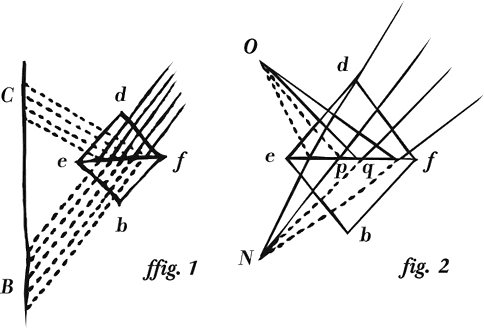 24 Tying two Prismes basis to basis def & bef together I so held ym in ye sun beames transmitted through a hole into a darke roome, yt they falling pretty directly upon ye base ef (in fig 1) were most of ym transmitted to B on ye paper CB; though some of ym were reflected to C by ye filme of aire ef betwixt ye Prismes.\But both C & D were white/ Then I inclined ye Basis (ef) of ye Prismes more & more to ye rays untill B changed from white to Red, & ye white at C became blewish; & inclining ye Prisme a little more ye Red at B \vanished/, & ye blewish colour at C became white againe. As in ye 22th Experiment.
24 Tying two Prismes basis to basis def & bef together I so held ym in ye sun beames transmitted through a hole into a darke roome, yt they falling pretty directly upon ye base ef (in fig 1) were most of ym transmitted to B on ye paper CB; though some of ym were reflected to C by ye filme of aire ef betwixt ye Prismes.\But both C & D were white/ Then I inclined ye Basis (ef) of ye Prismes more & more to ye rays untill B changed from white to Red, & ye white at C became blewish; & inclining ye Prisme a little more ye Red at B \vanished/, & ye blewish colour at C became white againe. As in ye 22th Experiment.
25 If I held ye said Prismes in ye open air as in ye 23d experiment, holding my eye at O (in ye 2d fig) to see ye reflected sky ye Phænomena were ye same as in yt 23d experiment; ep appearing darker yn qf, & pq being blew. But if I held my eye at N to see ye sky through ye base of ye Prismes ef (or rather through ye plate of aire betwixt those bases) there appeared ye contrary Phænomena \but much more plaine/ ep being very light, qf very darke, & pq very red. [The reason was given in ye 23d experiment
Note, That ye 22th & 24th (& all such like experiments yt {illeg} require yt ye rays coming from a luminous body be all parallell \wholly/ or almost parallell) would bee more conspicuous were ye suns Diameter lesse, & {illeg} therefore for such like experiments his rays may bee straitned through two small holes at a good distance assunder, as was done in ye 8th Experiment.
Also ye 23th & 25t Experiment ({&} \most/ other such like in wch {like} immediatly the rays passe immediatly from ye prisme to ye eye) would bee more conspicuous were ye Pupill lesse yn it is, And therefore it would bee convenient to looke through a small hole at ye Prisme.
26 The colours in ye portion pq appeared to ye eye O in this order
<8>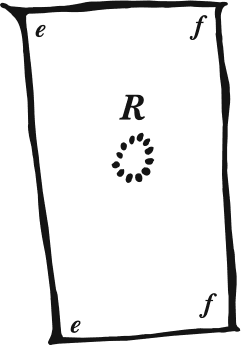 27 The two Prismes being tyed together then in trying ye 24th experiment, there appeared a white spot in ye midst of ye red colour B, & a darke spot in ye blewish colour C. And after ye base ef of ye Prismes was more more {sic} inclined to ye rays , |so| yt ye red colour vanished & yt (by ye laws of Refraction) noe light could penetrate ye filme of aire ef, yet ye white spot remained at B & ye blew darke one in ye midst of ye light at {illeg} C.
27 The two Prismes being tyed together then in trying ye 24th experiment, there appeared a white spot in ye midst of ye red colour B, & a darke spot in ye blewish colour C. And after ye base ef of ye Prismes was more more {sic} inclined to ye rays , |so| yt ye red colour vanished & yt (by ye laws of Refraction) noe light could penetrate ye filme of aire ef, yet ye white spot remained at B & ye blew darke one in ye midst of ye light at {illeg} C.
28 Holding my eye at O or N (in trying ye 25t Exper:) very obliquely to ye basis ef; {illeg} To my eye at O appeared a black spot \(R)/ in ye midst of ye white basis (or filme of aire) ef, & to my eye at N appeared a white spot \(R)/ in ye midst of ye black basis (or plate of aire) ef; through wch spot (as through a hole in ye midst of a black body) I could distinctly see any object, but could discerne nothing through any other parts of ye appearingly blak basis ef.
29 By variously pressing ye Prismes \together/ at one end more yn at another I could make ye said spot R run from one place to another; & ye harder I pressd ye prismes together, ye greater ye spot would appeare. to bee. [Soe yt I conceive ye Prismes (their sides being a little convex & not perfectly plaine) pressed away ye interjacent aire at R & becoming contiguous {at R} in yt spot, transmitted ye Rays {there} in yt place as if they had beene one continuous peice of glasse; whereas ye plate of aire \ef/ is a very reflecting body: soe yt ye spot R may bee called a hole made in ye plate of {are} aire (ef)].
32 The colours of ye circles (in ye 30th & 31th experiment) appeared more distinct at C yn at B, & to ye Eye O yn to ye Eye N. There being I conceive more colourlesse some colourlesse light reflected wth ye coloured light to O, & C \but/ much more colourlesse light transmitted to N & B; wch must needs whiten & b whiten & blend the colours.
<9>30 In ye 27th Experiment when ye colour white or red was trajected on B, there would apeare severall circles of colours about. {ye black} ye white spot at B & \also/ about ye da{rke} one at C. But these colours vanished {illeg} \together/ wth ye red colo{ur} at B: Growing greater & greater \distincter/ untill they vanished.
31 Likewise in ye 28th exper: when ye spot was in yt side ye partition pq next ye eye, it appeared coloured {illeg} to my eye both at O & N, encompassed wth divers circles of colours. Wch circles would grow greater & greater \distincter/ by how much ye coloured partition pq came nearer & nearer to ym (yt is by how much ye base ef was more & more oblique to ye rays) & soe vanished by degrees as ye said limb {illeg} pq came to ym. Before they began to vanish they appeared round or Ellipticall thus 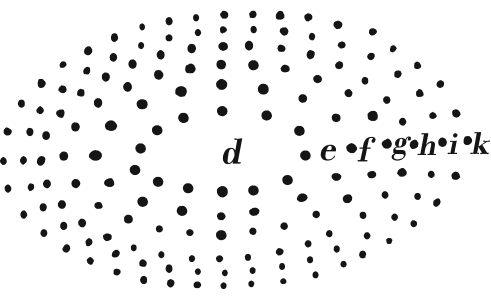 But in their vanishing {illeg} (especially if looked {on} through a hole much smaller then my pupill) they appeared incurved thus.
But in their vanishing {illeg} (especially if looked {on} through a hole much smaller then my pupill) they appeared incurved thus. 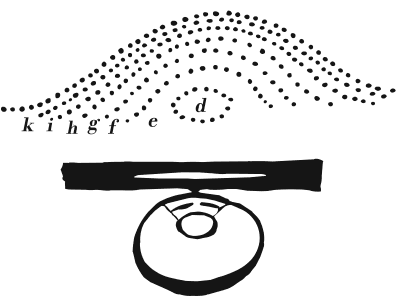 But I could see ye most circles when I looked on ym through a long slender slit, for {illeg} held parallel to ye coloured limb pq, when ye circles halfe disappeared: for yn I have numbered 25 {red} circles & {illeg} blew ones \esteeming each consecution of red & blew to bee one circle/ & could perceive ther were many more so close together yt I could not number ym; whereas wth my naked eye I could not discern above nine or ten red ones & as many blew.
But I could see ye most circles when I looked on ym through a long slender slit, for {illeg} held parallel to ye coloured limb pq, when ye circles halfe disappeared: for yn I have numbered 25 {red} circles & {illeg} blew ones \esteeming each consecution of red & blew to bee one circle/ & could perceive ther were many more so close together yt I could not number ym; whereas wth my naked eye I could not discern above nine or ten red ones & as many blew.
33 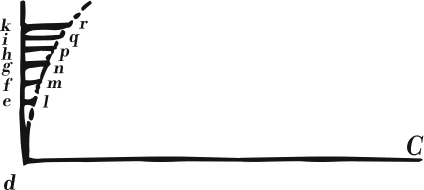 The circles are ye broadest nearest to ye center & so beeing narrower & narrower doe (I conceive by ye exactest measure I could make) increase in number as ye interjacent aire doth in thicknesse. (Sit cd = radio curvitatis vitri; efghik circuli colorum; & el = = = = = = crassitiei æris). And this I observed by a sphericall object-glasse of a Prospective tyed {sic} fast to a plaine glasse, so as to make ye said spot wth ye circles of colours appeare
The circles are ye broadest nearest to ye center & so beeing narrower & narrower doe (I conceive by ye exactest measure I could make) increase in number as ye interjacent aire doth in thicknesse. (Sit cd = radio curvitatis vitri; efghik circuli colorum; & el = = = = = = crassitiei æris). And this I observed by a sphericall object-glasse of a Prospective tyed {sic} fast to a plaine glasse, so as to make ye said spot wth ye circles of colours appeare
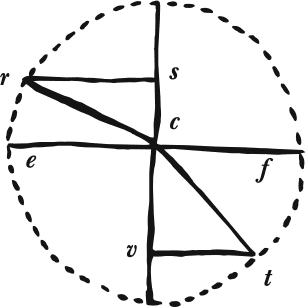 34 By the forenamed Prospective glasse I observed (though not very exactly) yt ye more obliquely ye ray tc was incident to ye filme of aire ef twixt ye glasses, ye {illeg} greater ye coloured circles are in this proportion: Viz: as ye summe of ye factus of ye motion of ye incident ray into its velocity {illeg} \perpendicularly/ towards ye aire ef & of ye factus of ye motion of ye ray said ray in ye aire ef into its motion \perpendicularly/ through ye said aire is to ye said factus when ye incident ray is perpendicular, {soe} soe is ye bignesse of ye coloured circles wn ye incident ray is perpendicular to ye bignesse of ye same circles wn ye incident ray is oblique, soe is dd x cv + ee x cs to dd + ee x ct. |But ye spot in ye midst is not made greater or lesse by ye obliquity of ye rays \rather ye contrary/|
34 By the forenamed Prospective glasse I observed (though not very exactly) yt ye more obliquely ye ray tc was incident to ye filme of aire ef twixt ye glasses, ye {illeg} greater ye coloured circles are in this proportion: Viz: as ye summe of ye factus of ye motion of ye incident ray into its velocity {illeg} \perpendicularly/ towards ye aire ef & of ye factus of ye motion of ye ray said ray in ye aire ef into its motion \perpendicularly/ through ye said aire is to ye said factus when ye incident ray is perpendicular, {soe} soe is ye bignesse of ye coloured circles wn ye incident ray is perpendicular to ye bignesse of ye same circles wn ye incident ray is oblique, soe is dd x cv + ee x cs to dd + ee x ct. |But ye spot in ye midst is not made greater or lesse by ye obliquity of ye rays \rather ye contrary/|
35 When ye rays were perpendicular to ye aire ef, ye diameter of 5 {sic} of ye circles was one parte, whereof 400 was ye radius dC of ye glasses curvity. the said radius being 25inches Soe yt (el) ye thicknesse of ye aire {illeg} \for one/ circle {sic} was inch or 0,000015625. [wch is ye space of the pulse of ye vibrating medium.] \by measuring it since more exactly I find = to ye said thicknesse/.
36 Accordingly as ye glasses are pressed more or lesse togeth{er} ye coloured circles doe {illeg} become greater or lesse. & as they are pressed more & more together new circles doe arrive in ye midst untill at last ye said pellucid spot R doth appeare.
37 The circles of colour appeare in this order from ye center to ye eye O Or on ye paper at C viz Darke (or pellucid), white, yellow, greene, blew, purple, Red, yellow, greene, blew purple, Red, yellow, Greene, blew &c. But to ye eye N or on ye Paper at B they appeare in this order Light (or pellucid) black, blew, Greene, yellow, Red, purple, blew, greene soe yt those circles wch appeare Red to ye eye O, appea{re} blew to ye eye N, & thos wch appeare blew to ye eye O appeare of ye contrary colour red to ye Eye N
<11>38 Those circles wch appeare Red to ye eye O, & blew to ye eye N are almost as broade againe as those wch appeare blew to ye eye O & Red to ye eye N.
39 Holding ye {illeg} said circles in a darke roome in ye blew rays made by a Prisme (as ye 10th Experiment) all ye said circles appeared {sic} blew but those wch in ye discoloured light appeared red appeared of a blew much more diluted yn ye others. And if ye Red Prismaticall rays fell upon those circles ye all ye circles appeared red but those circles wch in ye clear light appeared blew, in ye Prismaticall red rays appeared of a much fainter darker & obscurer red yn ye others.
40 Whither these circles were held in ye Prismaticall blew or red rays they still appeared of ye same bignesse.
41 Putting water betwixt ye two Prismes instead of ye {fill} filme of aire; There appeared all ye Phænom{ena} of ye said circles, & also of ye 22, 23, 24, & 25t Experiments |&c|. Onely somewhat more {illeg} obscurely becaus there is lesse refraction made out of glasse into water yn into aire; & yet
42 The coloured circles appeared as big when there was a filme of water as when there was a filme of aire betwixt ye {illeg} Prismes.
43 If you make ye pellucid spot R nimbly to run to  & fro. There will appeare another spot S to follow it, wch spot S exhibits such Phænomena as it ought to doe were it a Spot of aire, viz: {illeg} To ye eye O it appeares white next ye Spot R & yn yel Red &c, But to ye eye N it appeares black next ye Spot R & yn blew &c: wch colours it ought to have were it a filme of aire (by exper 37). But it is not a filme of aire because if ye Spot R rests a little, the water creepes into ye said spot S & makes it vanish. It seemes therefore yt ye water cannot nimbly enough follow ye spot R, but leaves ye space S empty to bee possessed by Æther alone, untill ye water have time to creepe into it.
& fro. There will appeare another spot S to follow it, wch spot S exhibits such Phænomena as it ought to doe were it a Spot of aire, viz: {illeg} To ye eye O it appeares white next ye Spot R & yn yel Red &c, But to ye eye N it appeares black next ye Spot R & yn blew &c: wch colours it ought to have were it a filme of aire (by exper 37). But it is not a filme of aire because if ye Spot R rests a little, the water creepes into ye said spot S & makes it vanish. It seemes therefore yt ye water cannot nimbly enough follow ye spot R, but leaves ye space S empty to bee possessed by Æther alone, untill ye water have time to creepe into it.
44 Refracting ye Rays through a Prisme into a darke rome (as in ye 7th Experiment) And holding another Prisme about 5 or 6 yards from ye former to refract ye rays againe I found ffirst yt ye blew rays did suffer a greater Refraction \by ye second Prisme/ then ye Red ones.
45 And secondly yt ye \purely/ Red rays refracted by ye second \Prisme/ made noe other colours but Red & ye purely blew ones noe other colours but blew ones.
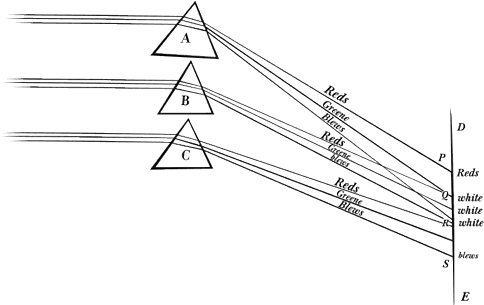 46 If three or more Prismes A, B, C, {illeg} bee held in ye sun soe yt ye Red colour of ye Prisme B falls upon ye Greene or yellow colour of ye Prisme A & ye Red colour of ye Prisme C falls on ye Greene or yellow colour of ye Prisme B; ye said colours falling upon ye Paper DE at P, Q, R, S. There will appeare a Red colour at P & a blew one {illeg} at S but
46 If three or more Prismes A, B, C, {illeg} bee held in ye sun soe yt ye Red colour of ye Prisme B falls upon ye Greene or yellow colour of ye Prisme A & ye Red colour of ye Prisme C falls on ye Greene or yellow colour of ye Prisme B; ye said colours falling upon ye Paper DE at P, Q, R, S. There will appeare a Red colour at P & a blew one {illeg} at S but 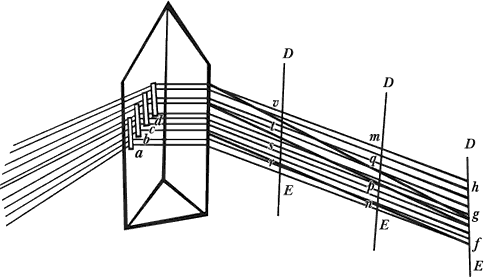 betwixt Q & R where ye Reds, yellows, Greenes, blews, & Purples {illeg} of ye severall Prismes are blended together there appeares a white.
betwixt Q & R where ye Reds, yellows, Greenes, blews, & Purples {illeg} of ye severall Prismes are blended together there appeares a white.
47 Or if you clean a peice of Paper on one side of ye Prisme wth severall slits a, b, c, d, in it parallel to ye edges of ye Prisme soe yt ye light passing through those slits make colours on ye Paper DE; If ye said paper be held neare to ye Prisme there will appeare for each slit a|,| b|,| c|,| d|,| a coloured line r, s, t, v. The paper being held farther of untill ye said coloured lines bee blended together, there will appeare white twixt p & q where those colours are blended; at m there appeares Reds & at n blews. But if ye paper bee still held farther of {sic} the white colour |(pq)| will appeare narrower & narrower untill it vanish. & then gh on one side appeares Red & gf on ye other side is blew.
49 A single superficies of Glasse reflects many rays whither they passe out of glasse into aire or out of aire into Glasse & yet two surfaces of Glasse when contiguous (by ye 27th 28th & 29th Experiment) reflect ye Rays noe more then if the glasses had beene one entire peice wthout such a superficies betwixt ym.
48 As white was made by a mixture of all sorts of colours (in ye 46th & 47th Experiment) Greene is made by a mixture of blew & yellow, purple by a mixture of red & yellow, &c
50 Thin fflakes of Muscovy Glasse, Bubbles wch children make of sope & water, ye thin skums of l molten leade, of cooling iron, water wiped very thin on glasse, glasse blowne very thin, &c represent ye Phænomena of ye coloured circles in ye 30th and 31st Exper &c. To wch may bee referred coloured motes in ye Sun or in liquors, or pouders, or sollid bodys; ye slender coloured threds of {illeg} some {illeg} cobwebbs, of silke wormes, & of flax finely dressed {in them} (though ye flax in spining loseth its glosse, because ye {illeg} flat thredds cleave together againe into {illeg} two greate a thicknesse see Exper 49 )
<14>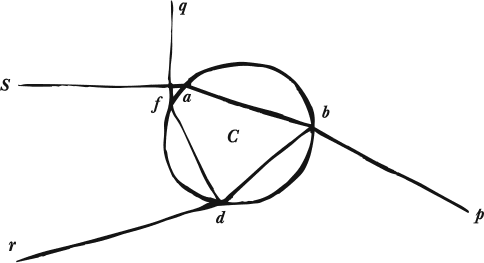 51 If ye Sun S shine upon a large glasse Globe abd filled wth water And if you {sic} hold your eye very neare to ye globe, ye rays bp will appeare coloured \redd/ & ye farther you hold yor eye from ye glasse ye lesse they appeare coloured, untill ye colour vanish. But ye Rays rd & fq appeare coloured at wt distance so ever yor eye bee placed from ye Globe. The like you may observe by letting ye colours fall on a peice of paper.
51 If ye Sun S shine upon a large glasse Globe abd filled wth water And if you {sic} hold your eye very neare to ye globe, ye rays bp will appeare coloured \redd/ & ye farther you hold yor eye from ye glasse ye lesse they appeare coloured, untill ye colour vanish. But ye Rays rd & fq appeare coloured at wt distance so ever yor eye bee placed from ye Globe. The like you may observe by letting ye colours fall on a peice of paper.
52 Though one termination of light trajected through ye Prisme will not make both blews & reds; yet in {illeg} this globe it doth (see Cartesij {illeg} Meteora {sic} cap 8 sec 9) ffor ye rays rd & fq make all sorts of blews & reds; indeed by ye rays bp ye red is very distinct but ye blew is scarce discernable.
53 The {sic} colours of ye Rainbow must bee explicated by ye rays rd & fq (vide Cartesij Meteor Cap 8 sec 1, 2, 3, 9, 10, 11, 12, 15) |ffor ye bow may bee mad by drops of water forcibly cast up into ye aire.|
54 The spot R (mentioned in Experimnt ye 52d) {illeg} grows lesse or lesse by how much ye rays fall more & more obliquely on {sic} ye intermediate filme of aire ef. [wch seemes to intimate |yt| ye thinness of ye intermediate filme of aire (or rather Æther) augments its refraction, untill (when ye glasses become contiguous) it bee equall to yt of glasse]
55 The surfaces of Glasse doe not reflect \soe much/ light when ye glasse is in water as when it is in aire & ye lesse any two mediums differ in refraction ye lesse their intermediate surface reflects light [wch intimates yt tis not ye superficies of Glasse or any smoth pellucid body yt reflects light but rather ye cause is ye diversity of Æther in Glasse & aire or in any contiguous bodys {illeg} though ye parts of ye Glasse must necessarily reflect some rays.
<15>56 The pouders of Pellucid bodys is white soe is a cluster of small bubles of aire, ye scrapings of black or cleare horne, &c: [because of ye multitude of reflecting surface soe are bodys wch are full of flaws, or those whose parts lye not very close together (as Metalls {sic}, Marble {sic}, ye Oculus Mundi Stone &c) whose pores betwixt their parts admit a grosser Æther into ym yn ye pores in their parts]. hence
57 Most Bodys (viz: those into which water will soake as paper, wood, Marble, ye Oculus Mundi Stone, &c) become more darke & transparent by being soaked in water [for ye water fills up ye reflecting pores]
58 If wth a bodkin gh
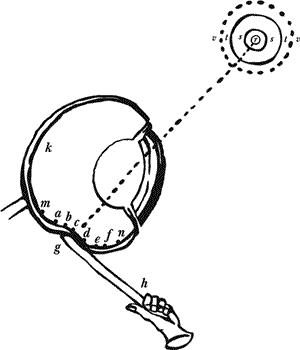 58 I tooke a bodkin {sic} gh & put it betwixt my eye & ye bone as neare to ye end of Backside of my eye as I could: & pressing my eye wth ye end of it (soe as to make ye curvature a, bcdef in my eye) there appeared severall white darke & coloured circles r, s, t, &c. Which circles were plainest when I continued to rub my eye wth ye point of ye bodkin {sic}, but if I held my eye & ye bodkin still, though I continued to presse my eye wth it yet ye colours circles would grow faint & often disappeare untill I renewed ym by moving my eye or ye bodkin.
58 I tooke a bodkin {sic} gh & put it betwixt my eye & ye bone as neare to ye end of Backside of my eye as I could: & pressing my eye wth ye end of it (soe as to make ye curvature a, bcdef in my eye) there appeared severall white darke & coloured circles r, s, t, &c. Which circles were plainest when I continued to rub my eye wth ye point of ye bodkin {sic}, but if I held my eye & ye bodkin still, though I continued to presse my eye wth it yet ye colours circles would grow faint & often disappeare untill I renewed ym by moving my eye or ye bodkin.
59 If ye experiment were done in \a/ light roome so yt though my eyes were shut some light would get through their lidds There appeared a {illeg} or redish spot in ye midst at {illeg} greate broade blewish darke circle outmost (as ts), & wthin that another light spot srs whose colour was much like yt in ye rest of ye eye as at k. Within wch spot appeared still another blew spot r, especially if I pressed my eye hard & wth a small pointed bodkin. |& outmost at vt appeared a verge of light|
60 But on ye contrary if I tryed ye experiment in very darke roome ye circle ts apeared of of a {illeg} Reddish light sr of a darkish blew & ye middle spot r appeared lighter againe; & there {sic} seemed to be a circle of darke blew \tv/ wthout ye circle ts ye outmost of all [I conceive (in ye 60th experiment) where ye curvature \of ye Retina/ at ma & fn began & was but little ye blew colour tv was caused; at ab & ef where ye Retina was most concave, ye bright circle ts was caused: at bc. & de where ye Retina was not much incurved nor strained ye darke blew circle sr was caused & at cd where ye Retina was stretched & made convex ye light spot r appe was caused. In ye 59th Experiment ye spirits were str perhaps strained out of ye Retina at ab, ef, & cd or otherways made incapable of being acted upon by light & soe {illeg} made darker colours \a lesse appearance of light/ yn ye rest of ye {eye} Retina]
61 That ye same circle ts wch appeared light in ye darke, appeared darke in ye light I {could} found by {remain} suddenly letting in light into a darke darke roome for yn ye bright circles would imediatly turne into darke ones & darke ones into bright ones.
62 I could sometimes perceive vivid colours of blew & red, \made by ye said pressure/ & perhaps a criticall eye might have discerned this order of colours. in ye 60th experiment viz from ye center greene, blew, purple, darke purple, blew, greene, yellow, red like flame, yellow, greene, blew, broade {sic} purple, darke.
63 Looking on a very light object as ye Sun or his image reflected; for a while after there would remaine an impression of colours in my eye: viz: white objects looked red & soe did all objects in ye light but if I went into a dark roome ye Phantasma was blew.
64 That vision is made in the retina appeares because colours are made by pressing the bakside of the eye; but when ye eye turns towards ye pressure, soe yt it is pressed before ye colours cease.
The Tunica Retina grows not from ye sides {of} of ye opticks {sic} nerv {illeg} (as ye other two wch rise one one from ye dura, ye other from ye Pia mater) but it grows from ye middle of ye nerve sticking to it all over the extremitys of its marrow. Which Marrow if {illeg} /the nerve\ bee any where cut cross wise twixt ye eye & ye union of the nerves, appeares full of small spots or pimples, wch are a little prominent, especially if the {illeg} nerve be pressed or warmed at a candle. And these shoot into ye very eye & may bee seene wth in side where ye retina grows to ye nerve: and they also continue {till} |to| ye very juncture EFGH. 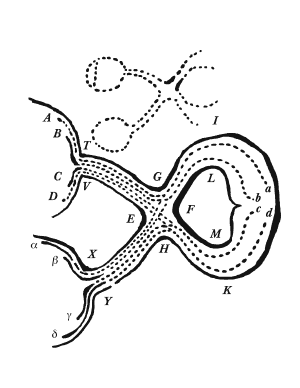 But at this juncture they end on a suddein into a more tender white pap like the interior part of the braine & soe ye nerve continues after ye juncture into ye braine filled wth a white tender pap in wch can bee seene noe distinction of parts as of betwixt ye said juncture & ye eye.
But at this juncture they end on a suddein into a more tender white pap like the interior part of the braine & soe ye nerve continues after ye juncture into ye braine filled wth a white tender pap in wch can bee seene noe distinction of parts as of betwixt ye said juncture & ye eye.
Now I conceive that every {sic} point in the retina of one eye hath its correspondent point in ye other, from wch two {pipes} very slender pipes \filled wth a most lympid liquor doe/ wthout either interuption or any other uneavenesse or irregularity in their processe, goe along the optick nerves {illeg} to ye juncture EFGH where they meete ye one halfe \either/ twixt GF ye other twixt or FH, & there unite into one pipe as big as bothe of them, & so continue in one passing either twixt IL or MK into ye braine where they are terminated perhaps at ye next meeting of ye nerves twixt ye Cerebrum & cerebellū, in ye same order that their extemities were scituate in the Retinals. And so there are a vast multitud of these slender pipes wch flow from the braine the one halfe through the right side nerve IL till they come of the juncture GF where they are each divided into two branches the one passing by G & T to ye right side of ye right eye AB, the other halfe shooting through ye juncture EF & soe passing by X to ye right side of the left eye αβ. And in like manner the other halfe shooting through the left side nerve MK divide themselves at FH & their branches passing by EV to the right ey & by HY to the left, compose that of the Retina in both eyes wch is towards ye left side, CD, & γδ.
Hence it appears i why ye two images of both eyes make but one image abcd in the braine. 2 Why when one eye is distorted objects appear double, ffor if ye image of any object bee made upon α in the one ey & β in the other, yt object shall have two images in the {illeg} brain at {illeg} a & b. Therefore the pictures of any object ought to bee made upon the corresponding points of ye two Retinas if upon A in ye right ey then upon α in ye left. If upon B then also upon β. And soe shall ye motions concurr after they have past ye juncture GH & make one image at a or b more vivid then {illeg} one ey alone could doe. 3 Why though one thing may appeare in two places by distorting the eye yet two things cannot appear in one place. If the picture of one thing fall upon A & of another upon α, they may both procee {sic} to p but noe farther, they cannot both be carried on ye same pipes pa into ye braine, that wch is trongest {sic} will there or most helped by fantasy will there prevaile & blot out ye other. 4 Why a blew seene by one eye & a yellow by the other at ye same time produces a greene unlesse ye fantasy make one colour prædominant. 5tly Why if one of the branches of ye nerve beyond ye juncture as at as at {sic} GF or FH should bee cut: That halfe of both eys toward ye wounded nerve would bee blind, the other halfe remaing perfect. 6tly Why the juncture is broader \almost as broad again/ twixt G & H then twixt E & F, becaus all the tubuli of both eys pass twixt G & H & but of them twixt E & F. \It is not quite so broad again because ye tubuli crossing in G are joining &c: also ye thicknes of the quicks &c./7tly why the {illeg} nerve GILF buts not directly upon the nerve XEHY but {illeg} in little transcends a \deviates/ a little towards TV because its Tubuli are to passe only into that side of the nerve EHYX towards EX. \The like of FMKH/ 8thly why the marrow of the nerve TVEG grows soft on a suddein when it comes at the juncture EF & more suddenly on that side towards G then towards E. And the like of the nerve EXYH. For it being necesary that the nerve TVEG {sic} should bee stretcht & bended severall ways by the motion of the eye: Therefore the tubuli are involved in severall to or wrought up wth in the substances of severall tough skins wch being foulded up together compose ye marrow of ye nerve, pretty sollid & flexible least ye tubuli should be prejuced by the severall motions of the nerve. And those small pimples or prominences wch appeare in the nerve cut crosse wise I conceive to bee of made by the foldings of these crasser skins. But the nerve at ye juncture EGFH being well guarded from all violence &c. motion caused by the motio by the bones into wch it is closely adapted: tis not necessary the said membranes substance should be continued any further then EG therefore the tubuli there on a suddein unsheath themselves there on ye inner side of the nerves {illeg} towards VE & XE may severally crosse twixt EF & bee united wth their correspondents on the other sides YH & TG. Now because ye inner tubuli must first crosse before they can convene wth the outmost tubuli of the opposite nerve hence it is that ye nerves grow soft sooner on ye inner side at E {sic} then on ye outer side at G & H.
9thly why ye two nerves meet a second time in the braine, because ye two half images caried along IL & MK may bee againe unite united into one complete image in the sensory. Note yt ye nerves at their contact | meeting are round about disjoyned from ye rest of the braine, nor are they soe thick theire as a little before their meeting. But by their externall figure they seeme as if the capillamenta concentered \like ye radii of a hemisphere/ to a point in ye lower part of the juncture. And tis probable yt the visive faculty is there for else why doe the nerves swell there \to so great a bulke/ as it were preparing for their last office, why doe they run \directly/ crosse from eitherside {sic} the braine to {sic} meet there {sic} if the {sic} designe was {illeg} they might not cumber by to have ye motions coveyed by the short cut from ye eye to ye {illeg} sensoriū before they grew too weak. If they were to proceed further their meeting their swelling {to} so great a bulke, they might have gone a shorter cut & in a lesse channell. There is indeed a marrow shoots from under them toward ye cerebellum {illeg} to wch they are united but ye greatest part of their substance if not all of it shoots {illeg} lys above this marr{ow} & also shoots \cross/ beyond it to ye center of the brain where they meet. Lastly the substance here is most pure, ye scituation {illeg} in ye midst of the brain, & {illeg} where \they/ constituting ye upper part of that small passage twixt |all| ye ventricles. {illeg} \where all/ superfluous humors have the greatest advantages to slide away that they may not incumber yt prcious organ
Light acts not upon seldom striks upon ye parts of grosse bodys (as may bee seen in its passing freely through them), its reflection & refraction is made by ye diversity of æthers, & therefore it effectes {sic} on the Retina can only bee to make this vibrate wch motion then must bee either carried in {pupil} \ye optick nerve/ to ye sensorium or produce other motions that are carried thither. Not ye latter for water is too grosse for such subtile impressions & {illeg} as for animall spirits though I tyed a peice of ye optick nerve at one end & warmed it in ye middle so {sic} see if any aery substance by that meanes would disclose it selfe in bubbles at the other end, I could not spy the least bubble; a little moisture only & ye marrow it selfe squeezed out. And indeed they that know how difficultly aire enters small pores of bodys, have reason to suspect yt an aery body though much finer then aire can pervade easily & wthout violence (as it ought to doe) ye small pores of the braine & nerves, I should say of water, because those pores are filled wth water, & if it could it would bee too subtil to bee imprissoned by ye dura mater & Skull, & might passe for æther. However, bee those spirits \wt need of such spirits much/ Motion is ever lost by communication especially twixt bodys of different constitutions. and therefore it can noe way bee conveyed to ye sensorium so entirely as by the æther it selfe Nay granting mee but that ther are pipes filld wth |a| pure {illeg} transparent liquor passing from ye ey to ye sensoriū & ye vibrating motion of ye æther will of necessity run along thither. ffor nothing interrupts that motion but reflecting surfaces, & therefore also yt motion \cannot/ stray out of its pipe through ye reflecting surfaces of ye pipe but must rush along (like a sound in a trunk) intire to ye sensorium. And that vision bee thus made is very conformable to the sense of hearing wch is made by like vibrations.
ffrom ye whitenes of the brain \& nerves/ the thicknesse of its vessells may be determined & their cavitys guessed at. And its pretty to consider how these agree wth the utmost distinctnesse in vision. As also wth ye intent of nature in conveying distinctly {sic} ye motions of the Aether {sic}.
<22>If rays be incident out of glasse upon a film of of {sic} air terminated twixt two glasses, the thicknesse of a vibration is , or part of an inch
If water was put twixt the glasses the thickness of a vibration was inch, of of its former dimensions. |viz as ye densitys of the interjected mediums.|
If ye rays were incident obliquely, the circles increase so that their {illeg} diameters are as ye secants of the rays oblique \incidence/ on ye sphericall film of aire obliquity wthin the film of air, or reciprocally as their celerity wthin the said film.
And the thicknesse belonging to each vibration is as the squares of those secants of celeritys, And ye lengths belo of ye rays belonging to each vibration as their cubes.
The first pulse ends at the first dark circle
The thicknesse of a pulse of \extream/ rubiform rays to that of purpuriform ones perpendicularly incident is greater then 3 to 2 & lesse then 5 to 3. viz as 9 to 14 or 13 to 20. And the thicknesse belonging {sic} to each coulour is {illeg} 13, \14/ 14 {sic}, 15 16. 17. 18. 19. for extreame purple, intense purple, Indico, blew, green, ye terminus of green & yellow, yellow, orange, red, extream red.
Mr Boyle mentions one that by sickness became so tender sighted as in ye dark night to see & distinguish plainly ye colours of ribband (& other objects) on purpose pinned on ye inside of his curtains against he awaked. Of ye determinate nature of Effluviums p 26, And of another yt by a feaver became of so tender hearing as to hear plainly soft whispers at a distance wch others could not at {sic} all perceive, but when he grew well his hearing became but like yt of other men. Ibid.
Stipic vegetables, as gall, oaken bark, red roses, Logwood, Sumach &c turn vitriol to \a/ black precipitate
